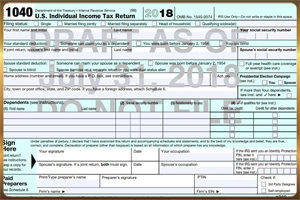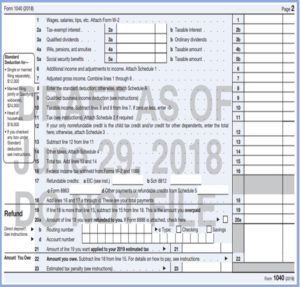The Draft 1040
- 07
- Aug
 The ratification of the 16th Amendment allowed for the collection of income tax. Starting in 1913, American taxpayers used IRS Form 1040 to prepare and file their tax returns. The first tax return was three pages with only one page of instructions. Over the last 100+ years, the length of the instructions has changed numerous times.
The ratification of the 16th Amendment allowed for the collection of income tax. Starting in 1913, American taxpayers used IRS Form 1040 to prepare and file their tax returns. The first tax return was three pages with only one page of instructions. Over the last 100+ years, the length of the instructions has changed numerous times.
In 2017, Congress passed the largest piece of tax reform legislation in over three decades. To conform to the changes that need to be implemented due to this new Tax Cuts and Jobs Act, the IRS released over 50 drafts or revised forms and schedules on its website in June.
The most anticipated one was the 1040, U.S. Individual Income Tax Return form. As promised, the “postcard” size was achieved, and Form 1040 was reduced to one double-sided half page, as compared to the previous two full pages. The objective was to simplify the tax reporting process for many taxpayers. The first page is primarily text data including contact information, social security number, filing status, dependents, signature, and of course, the option to donate to the presidential election campaign. The second page is dedicated to the actual monetary information needed to complete this tax form. This new 1040 also consolidates and replaces 1040A and 1040EZ, two forms that will no longer be necessary. This means that starting in 2019 (for 2018 tax returns), all 150 million taxpayers will be using the same form.
The Treasury projects that 65% of taxpayers will only have to file the new 1040, plus at most one additional schedule. However, that leaves the remaining 35% potentially finding this attempt at simplification more confusing than ever.
When looking at the proposed 1040, here are things to remember.

It’s still a draft.
The IRS warns taxpayers not to file the recently released 1040 as it is still in draft form, stating, “This is an early release draft of the 2018 IRS Form 1040, U.S. Individual Income Tax Return, which the IRS is providing for your information,
review, and comment… Do not file draft forms. Also, do not rely on draft forms, instructions, and publications for filing. We generally do not release drafts of forms until we believe we have incorporated all changes. However, in this case we anticipate it is likely that this draft will change at least slightly before being released as final. Whether this draft changes or not, we will post a new draft later this summer with our standard cover sheet indicating we do not expect that draft to change.”
As promised, it’s smaller.
The new 1040 has only 23 numbered lines, as compared to the previous 79 on the old 1040 form. As previously stated, it should replace not only the 1040 but also forms 1040a and 1040EZ. Many lines have been consolidated or moved to schedules.
Does size really matter? The IRS expects that almost 90% of taxpayers will file their taxes electronically or use a tax preparer, making the length of tax forms inconsequential. The changes, additions and deletions of lines, which are supposed to make it easier to fill out and understand, are what matter the most.
Steve Mnuchin, Treasury Secretary, said, “Our objective is to make this simpler for taxpayers, whether they’re doing it electronically or whether they’re doing it on a physical form.”
It has six additional schedules.
The new 1040 has created a “building block” approach to tax reporting. Ideally, taxpayers with straightforward taxes will embrace this simplified form, however, those with more complex finances will have to be mindful of the schedules and what are included on them. For example, deductions and other items are now relegated to a schedule. Some individuals may become confused or overlook potential tax breaks due to them no longer being on Form 1040 and must be filled out on a separate schedule. For example, this includes student loan interest deductions, teaching supply deductions and taxes on household employees. While these schedules are mostly short in and of themselves, they could complicate the tax filing process for many taxpayers.
The schedules are:

- Schedule 1: Additional Income and Adjustments to Income. (37 lines)
Includes lines 10 through 37 from the 2017 1040 form. This schedule contains items such as capital gains and losses, student loan interest expense and business income.
- Schedule 2: Tax. (7 lines)
You’ll find the previous 1040 lines 44 through 47 on this schedule, including the Kiddie Tax, alternative minimum tax and excess premium tax credit refunds.
- Schedule 3: Nonrefundable Credits. (10 lines)
This includes information from the previous 1040 lines 48 through 55, including credit for child and dependent child care, education credit and energy credit.
- Schedule 4: Other Taxes (12 lines)
This includes the lines 57 through 63 previously on the 1040, including Medicare, Social Security, household employment and net investment income taxes.
- Schedule 5: Other Payments and Refundable Credits (14 lines)
This includes what was formerly on the 1040 as lines 65 through 74.
- Schedule 6: Foreign Address and Third-Party Designee. (3 rows)
This simply provides taxpayers with a foreign address a line to list their country, province and postal code and provides a place to list a third-party designee who is authorized to discuss the return with the IRS.
These new schedules do not replace the current schedules such as Schedule C – which will be modified with any changes necessary to reflect the changes in the new tax law.
Some items were removed due to the new tax code.
As some items were taken out of tax code, they were consequently taken out of the 1040. For example, there are no personal exemptions available for 2018 – 2025, so these lines were removed.
The former area for adjusted income reporting was eliminated. Line items that were not eliminated from tax code can now be found combined on other lines or the new Schedule 1.
An item was added due to the new tax code
Line 9 was created for the 20% deduction for income earned by pass-through businesses such as partnerships and S corporations.
Schedule 4 – “Other taxes”
Line 14, labeled as “Other Taxes” will refer you to a new Schedule 4. This schedule is for a collection of “other taxes” including self-employment tax, Medicare and Social Security tax, high-income household taxes, household employment tax, repayment of first time homebuyer credit, net investment income tax and the penalty for not having health care (2018 will be the last year this penalty is included).
Do you have questions about the draft 1040?
The IRS has a special email for those who have questions about the new draft form 1040. You can contact them at WI.1040.Comments@IRS.gov. They do warn however, that they cannot respond to all comments due to high volume.
Conclusion
As mentioned, it is expected that 90% of taxpayers will file their taxes electronically or use a tax preparer. Some people are speculating that the changes are merely aesthetic. “Is this a question of form over substance?” asked Bob Kerr, Executive Vice President of the National Association of Enrolled Agents. He also questioned individual states ability to adjust to the new forms, citing, “Are states ready to adjust their programming as IRS iterates version of the new Form 1040?” The changes will be costly as it will require many state and local tax forms to conform to the changes(www.money.us.news.com 7/5/2018).
The main attempt was to streamline the tax recording process for most taxpayers. The final judgement will start after the forms are finalized and taxpayers begin to use and file them.
Our aim is to try to be proactive about tax planning. We are keeping an eye on the changes and how they may affect your investments. Our goal is to understand your specific needs and then create a plan to address those needs. We anticipate sending clients a year-end tax report that will offer ideas on tax planning. We are here to help our clients! If you have any questions please call us.
Please share this information with others!

This year, our goal is to offer services to several other clients just like you! If you would like to share this information and our services with a friend or colleague please call Financial Advisors Network at
(714) 597-6510 and we would be happy to assist you.
Financial Advisors Network, Inc. is a Registered Investment Adviser. This post is solely for informational purposes. Advisory services are only offered to clients or prospective clients where Financial Advisors Network, Inc. and its representatives are properly licensed or exempt from licensure. Past performance is no guarantee of future returns. Investing involves risk and possible loss of principal capital. No advice may be rendered by Financial Advisors Network, Inc. unless a client service agreement is in place.
This article is for informational purposes only. This information is not intended to be a substitute for specific individualized tax, legal or investment planning advice as individual situations will vary. For specific advice about your situation, please consult with a tax professional or financial professional. Source: irs.gov; forbes.com; money.usnews.com; journalofccountancy.com. This article provided by the APFA © 2018.
- Financial Advisors Network Customer Service
- Articles
- Comments Off on The Draft 1040



